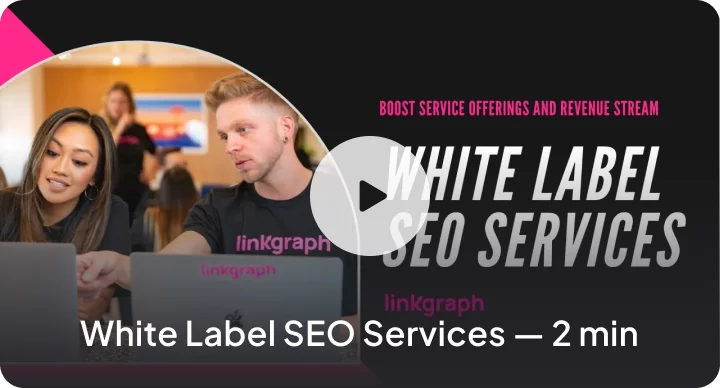SEO-Friendly Blog Posts: How and Why to Write Them
Adding blogs to your content strategy can help you rank for more keywords over time. Learn how to write SEO-friendly blog posts.
Every business can benefit from incorporating SEO blog writing into their digital strategy. Having a blog on your website allows your brand to target new keywords and share useful, helpful, and original content with your target audience.
To write SEO-friendly blog posts, it’s essential to ensure that your company’s content is optimized for the right keywords, shown to the right target audience, and is properly crawled, indexed, and understood by search engines.
Here’s a complete guide on how to write SEO-friendly blog posts and the many benefits of having a library of useful content assets that permanently live on your website.
To learn how to write seo-friendly blog content, sign up for LinkGraph’s SearchAtlas software. Our software includes powerful content tools like the SEO Content Assistant, Blog Topic generator, and our Meta Tag Optimizer.
What is SEO-friendly Blog Content?
Google looks to fill search engine results pages with unique, original, and valuable content. Blog posts are an excellent opportunity for your brand to demonstrate industry expertise and authority.
Creating SEO-friendly blog posts encompasses more than just keyword research and meta tag optimization. Google looks for other relevance and quality signals on the page, like semantic richness, originality, content length, topical depth, and even expert authorship.
The effective use of keywords and backlinks are ideal means of signaling relevancy and authority. However, content quality remains Google’s number one priority. The most important goal to strive for with every blog you publish is to satisfy the searcher’s intent.
The best way to begin formulating SEO-friendly blog content is to examine trending topics within your current niche. To start generating ideas, consider the following questions.
- What industry-related questions does my target audience have?
- Does my company have any special areas of expertise?
- What are trending topics that my company has authority in?
- Does my audience need help understanding my products or services?
- What topics are my competitors writing about?
Why are SEO Blog Posts Important?

There are so many benefits to regularly publishing blog content on your website. These benefits extend beyond just helping your audience, but have major benefits to improving your overall rankings in search engines.
- Blog content can increase your total keyword rankings, meaning more market share
- Having permanent content assets on your website can drive traffic for the long-term
- Showing up for lots of relevant keyword searches in your industry improves brand awareness, even if the user doesn’t click to your website
- Blog posts are great assets to link to and are a safe way to increase your site authority through link building
How to Write SEO-Friendly Blog Posts
Blog writing can be informational, insightful, or in the style of a how-to guide. But in summary, great quality blog content provides readers with a better understanding of the particular topic they are researching.
Blog writing for SEO success can seem complicated given the intricacy of search engine ranking factors. But to simplify the process, know that search engines and users define great content by the following qualities:
- Relevancy
- Comprehensiveness
- Readability
- Authority
Keeping these four elements in mind will help your brand perfect its content strategy while building brand awareness and fostering industry relationships through blog content.
1. Find Relevant Topics Through Keyword Research
Relevancy is one of Google’s driving factors in earning page 1 SERP rankings. That’s why first and foremost, your SEO blogging should always be guided by a strong keyword strategy.
To start identifying relevant keyword targets for blog posts, do the following.
Find Blogging Opportunities with the Keyword Researcher
The Keyword Researcher tool in your dashboard can help you find multiple relevant keyword phrases that present blogging opportunities.
Most likely, your primary product or service pages are targeting the most valuable keywords in your industry. Blog posts, however, present the opportunity to target relevant long-tail keyword phrases. Long-tail keywords usually have smaller search volume but still display strong search intent.
To get started, input the primary keyword target that you want to rank for into the Keyword Research tool. Then, use the “Related Keywords,” “Autocompletes,” and “Questions,” feature to see other phrases users are entering into the Google search bar that have a relationship to your primary keyword target.
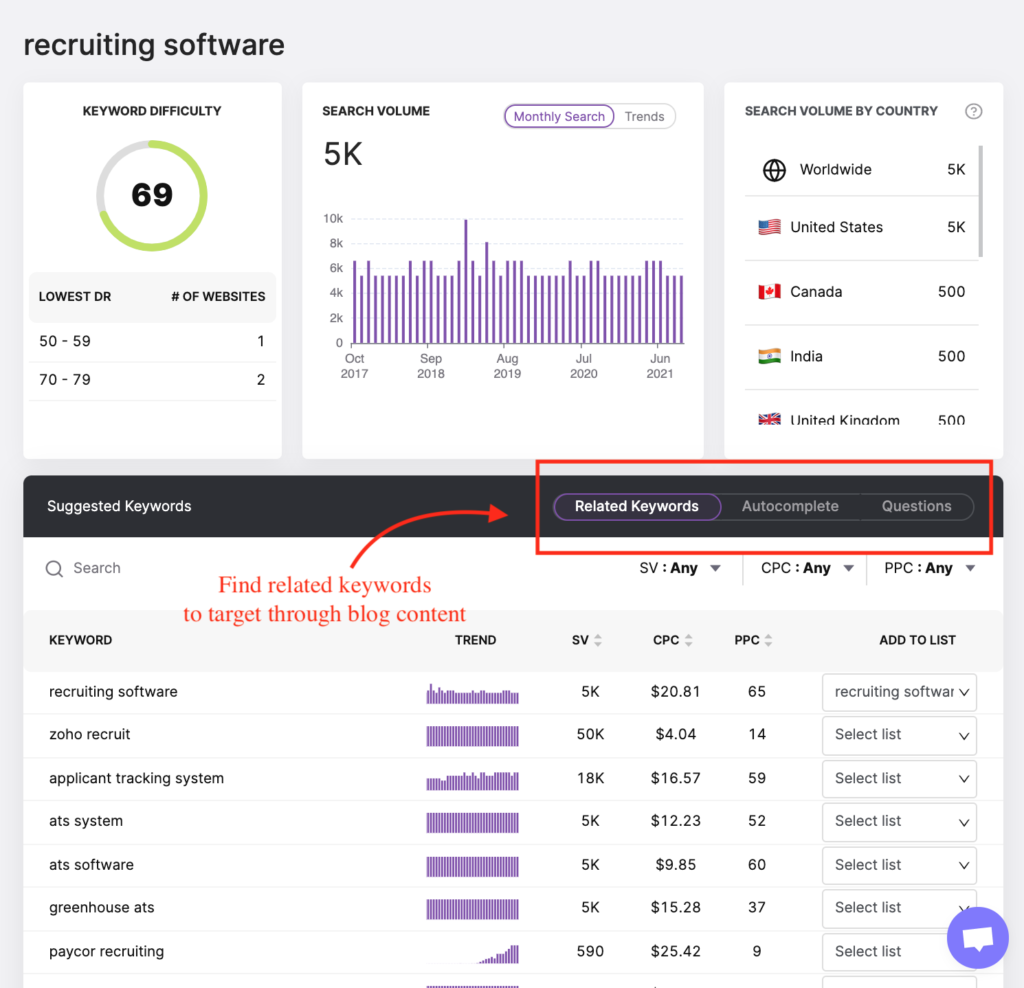
Once you have a list of relevant keyword targets, you can start generating blog ideas around them.
Use the Blog Ideas Feature in the SEO Content Assistant
To generate blog post ideas, you can certainly rely on the power of your own creativity and brainstorming. But if you need a little more help, use the Blog Ideas tool in your SearchAtlas dashboard.
First, enter the keyword target that you want to create a blog post around.
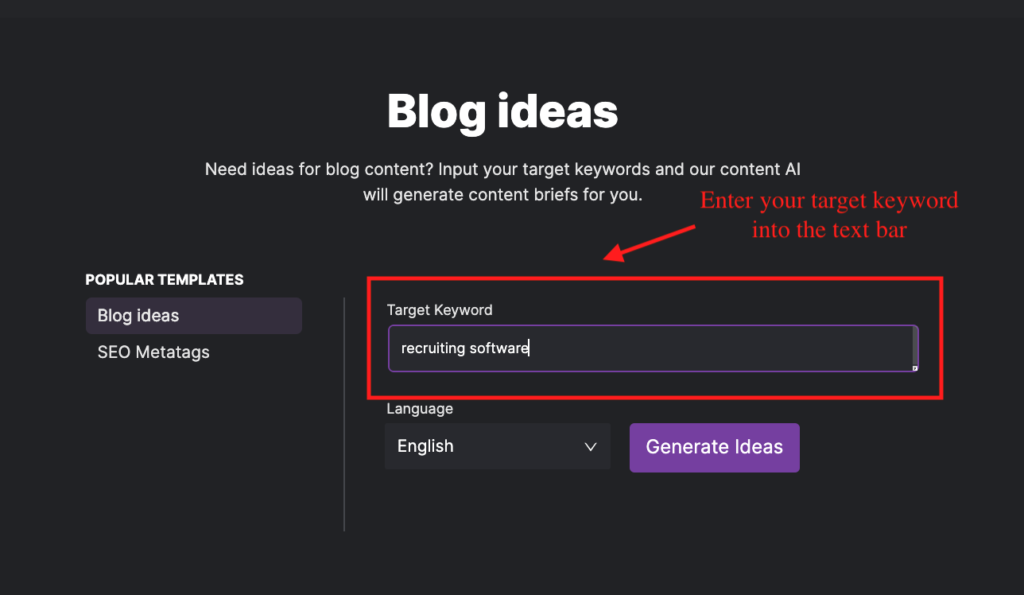
Then click “Generate Ideas.” The tool uses GPT-3 technology to develop blog post titles as well some accompanying text to help you get your blog started.
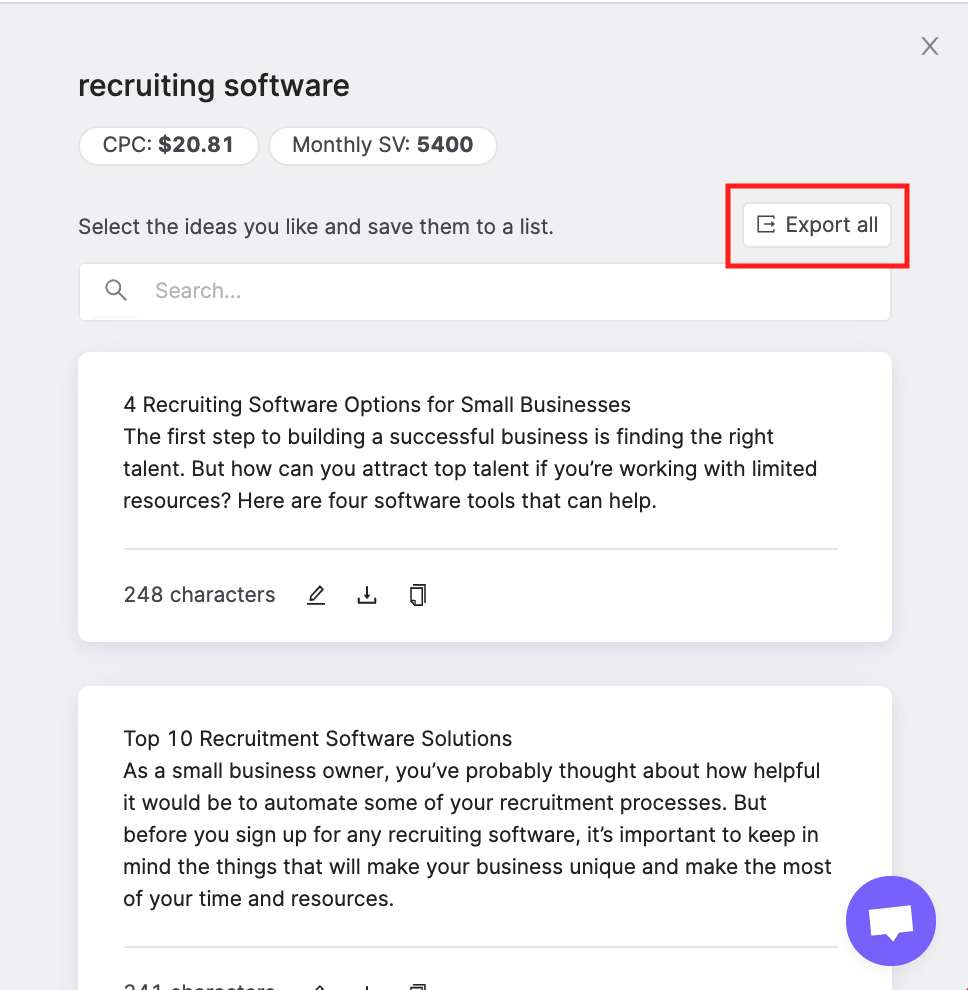
If you’d like, you can export your blog ideas to a CSV file to review them with your in-house team of writers.
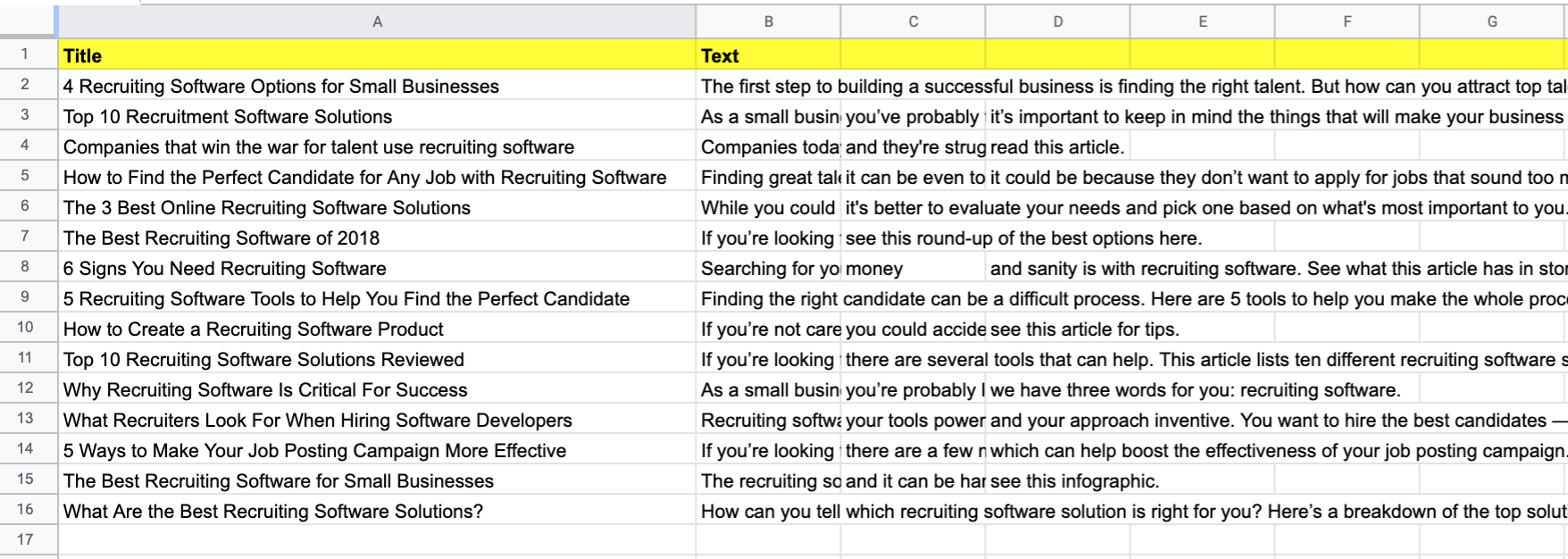
Develop an Editorial Calendar with your Blog Topics
Every blog post you create should target a new keyword. That’s because every keyword presents a new opportunity to get your content in front of more potential customers.
So ideally, your brand should be regularly writing and publishing blog posts. An editorial calendar can help you stay consistent, meet deadlines, and then track the SEO progress of the blogs you publish.
When do you stop generating blog ideas? Well, until all of the questions that your potential customers ask are answered on your website.
Because there are literally thousands of ways that users are searching for products, services, or expertise like yours, your blog content should be ongoing for as long as your website exists.
2. Create Comprehensive Blog Posts to Signal Quality
After you have your keyword targets and blog titles, it’s time to get writing.
The most important goal of SEO blog writing is to satisfy your user’s intent. Is the user looking for an answer to a specific question? A tutorial for how to use a product? A how-to guide or a top-ten list? More than anything else, your blog should satisfy the user’s initial search query.
But in addition to relevance, Google will also be looking to see whether your blog posts are as high quality as your competitors. Here are some types for creating in-depth, quality blogs that search engines will love (and thus rank better in the SERPs).
Take a Look at Your Competitors
When trying to understand what will help your blog posts rank well, there’s no better place than to look at your competition.
The SERP Overview feature in the Keyword Researcher will show you what content is already ranking for your target keyword.

Review the top-ranking content and take note of page titles, heading tags, rich media, content length, and other factors.
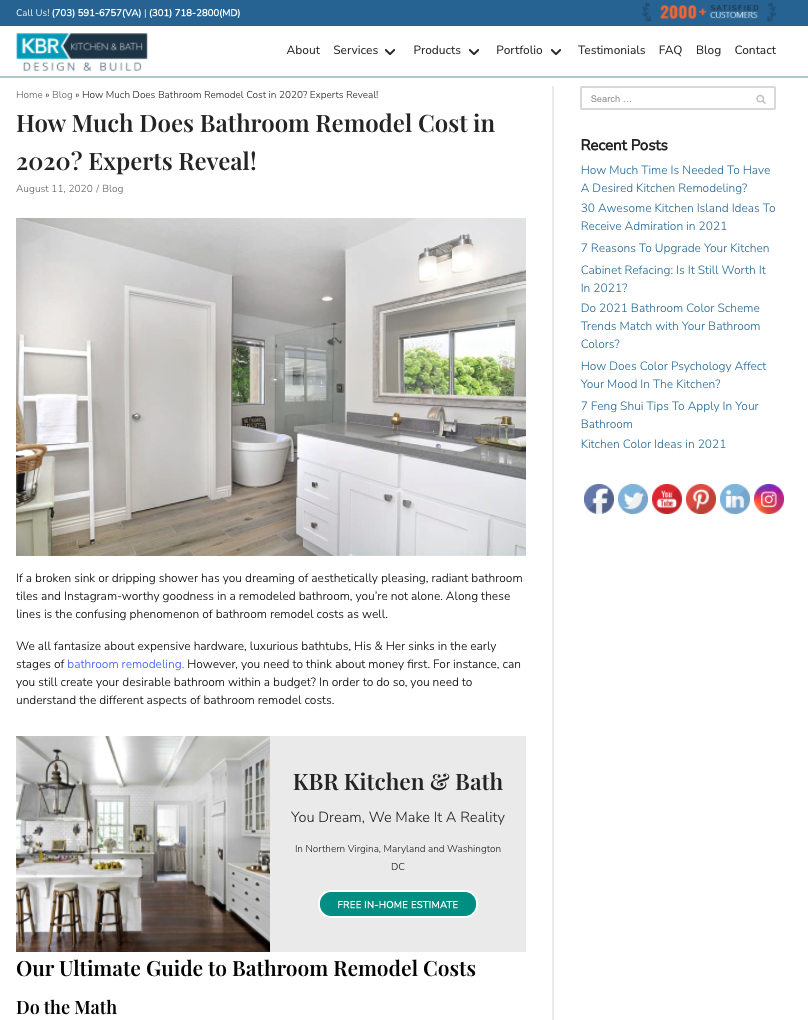
Then, do your best to emulate those elements in your own blog post.
See What Google is Showing Users Who Search for your Keyword
Google helps searchers on their quest for knowledge with autocomplete suggestions and the “related search” section near the bottom of the search results page. These features can also help you develop your blog posts to be more comprehensive.
For example, say your general contractor business wants to write a blog post about the costs associated with bathroom remodels. The SERP autocompletes and Related Searches feature can provides some insights into related questions that users are asking about the topic.
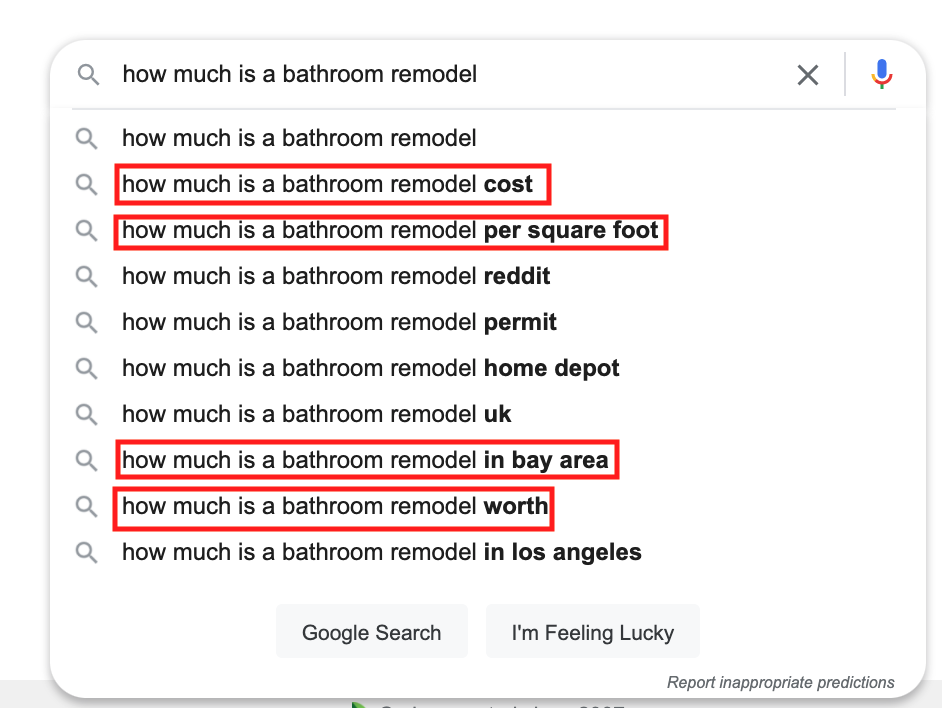
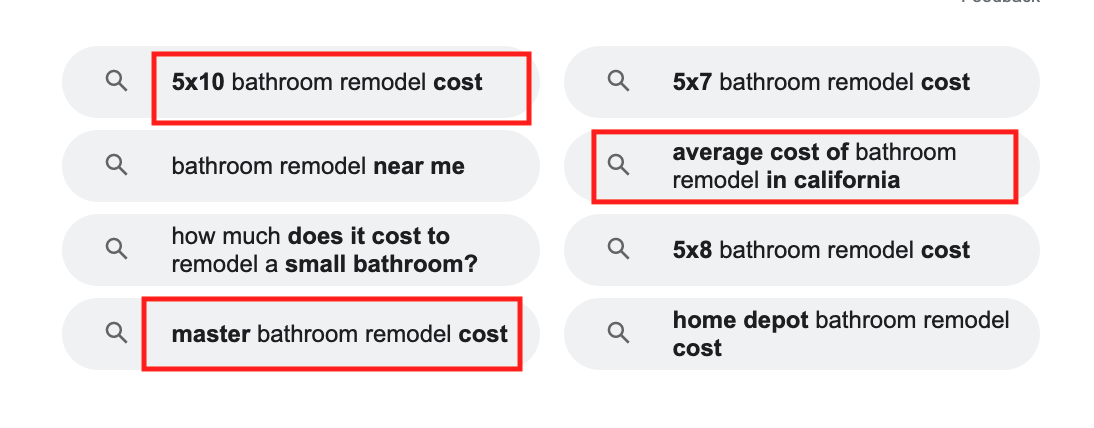
Instead of just focusing on the costs of a bathroom remodel, your blog post should also break down cost by various square footage, the costs based on location, as well as how much value a remodel can add to the home.
If the user finds all of the answers to these questions in your one blog post, they are less likely to return to the SERPs with more questions, which signals to Google that your post is comprehensive and useful.
Improve the Semantic SEO of your Blog Posts with the SEO Content Assistant (SCA)
Semantic SEO is the practice of satisfying user intent through semantics.
Semantically-rich content not only contains the target keyword, but related keyword phrases, subtopics, and answers to common questions that users have in relationship to the topic.
To write your SEO-friendly blogs with semantic SEO in mind, use the SEO Content Assistant in your dashboard. The tool uses NLP technology to suggest the relevant focus terms and questions that will give your blog more ranking power.
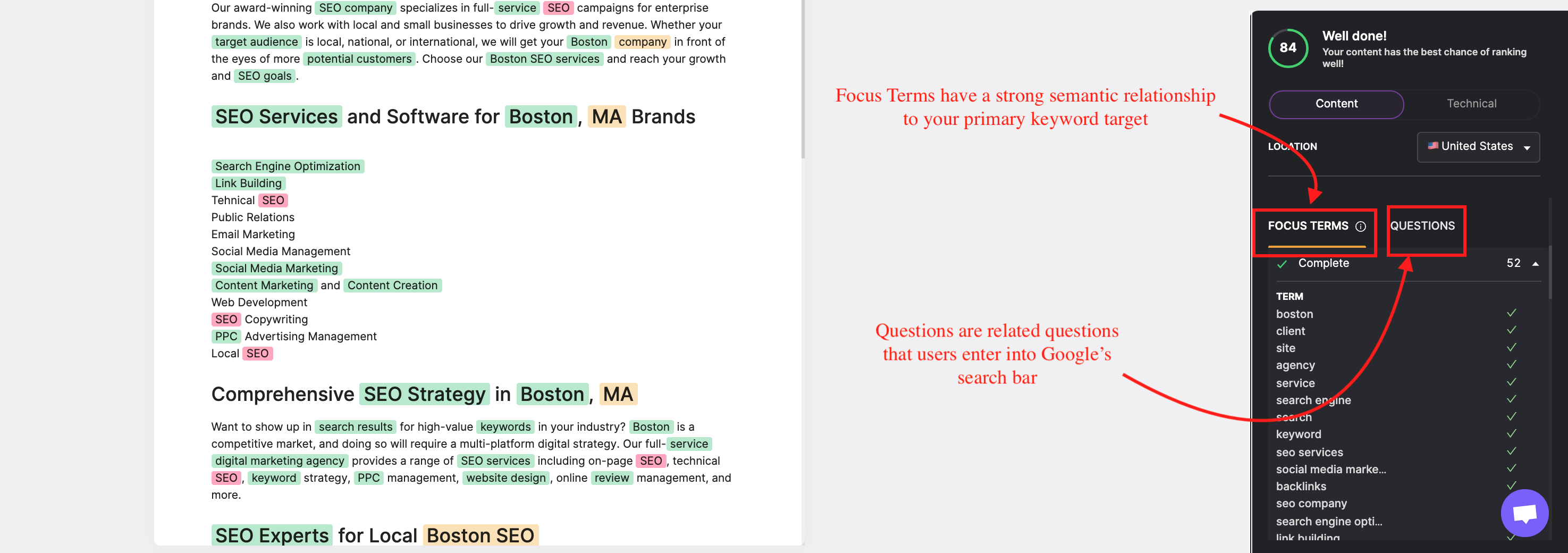
Don’t Shy Away From Lengthy Content
Word count is technically not one of Google’s ranking factors. But the length of your content can often signal quality to Google. Google doesn’t like thin content, and if your blog doesn’t appear as comprehensive as your competitors, it’s unlikely Google will rank your content over theirs.
3. Use SEO Best Practices to Improve Readability
Readability is a bit of a broad term, but for SEO purposes, it refers to how easily digestible your content is for both Googlebots and readers.
The same way grammatical errors, typos, and poor punctuation signal poor quality to readers, unoptimized ALT text, lack of visuals, and generic page titles send red flags to site crawlers.
There is no such thing as search SEO-friendly content that is not user-friendly; they go hand in hand. So here are some optimization best practices that will help improve your readability for both users and Google crawlers.
Avoid Keyword Stuffing
Using target keywords to signal relevancy is one of the first SEO tips many people ever learn. However, there is such a thing as overusing keywords.
A great way to check if your content is overstuffed is by examining its readability. Does it sound natural? Would you phrase that differently if your list of keywords didn’t exist?
Of course, some accommodations will be made to assist Googlebots in crawling and indexing your webpages. Nevertheless, they should not compromise a reader’s user experience.
Use the Page Title to indicate precisely what the Blog Post Covers
The Page title and meta description should adequately describe the content and utilize your target keywords. Remember, these elements will appear on the frontend of the SERP results for the user and will significantly influence your click-through-rates.
The Technicals feature of the SearchAtlas Chrome Extension can help you confirm whether or not the meta data of your blog posts are SEO-friendly.
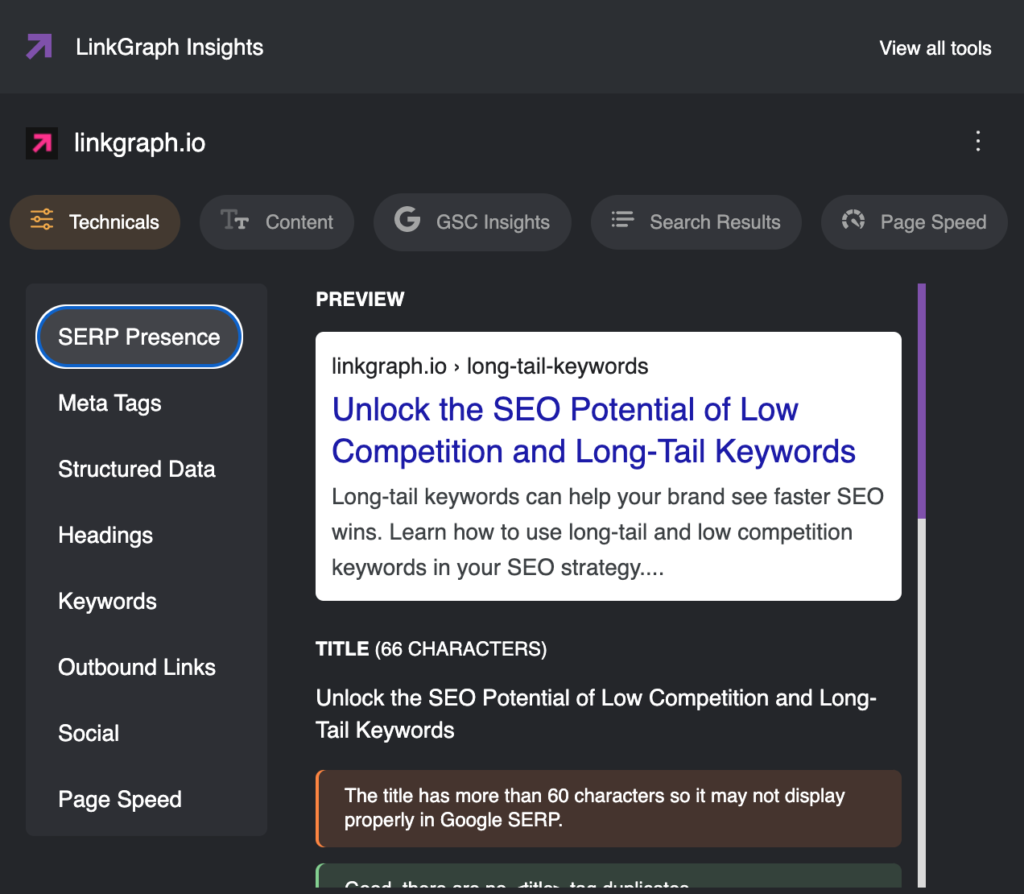
Let the H1-H6s Give your Blog Post a Clear Structure
Meta tags are best known to help Google crawlers understand what your content is about. But because meta tags are also visible to the user on the frontend, they can help with the readability (or the scannability) of your blogs.
The reality is, most users will scan your content looking for the most direct answer to their question. Headings can help you make your content more readable by making it more digestible.
With Google’s Passage Ranking update, crawlers will also be looking to promote specific passages of your content that directly answer the user’s question. Your heading tags are key to Google knowing where that information is on the page.
Optimize your Anchor Text
Bad anchor text is the trademark of poor user experience. There is nothing more irritating than clicking on a link that navigates you to irrelevant content.
Additionally, if you use bad anchors for internal links, your website’s bounce rate will increase. Once users realize the link does not bring them to the relevant content the anchor text promised, they are likely to leave the webpage immediately.
Anchor text should be an accurate description of what lies on the other side of the link. An optimized anchor text SEO strategy will also help Google better understand how your multiple blog posts and content assets interrelate.
Break Up Longer Posts with Rich Media
A long, uninterrupted wall of text can be intimidating for users. Infographics or images that contain helpful information can make your content appear more easily digestible, regardless of word count.
Consider using rich media to support your blog ideas and encourage users to interact with your content. Even a simple screenshot can be the visual stimulation needed to keep readers engaged.
This practice can also boost your visibility in vertical searches by allowing your content to appear when searchers use the images or video tab on the search engine results page to narrow down their results. Make sure you add optimized alt text so your images can show up in relevant searches.
4. Elevate Authority By Building Backlinks to your Blogs
After your blog is completed and published live on your site, improving the PageRank on the page will help elevate it in relevant keyword searches.
Every time another web page links to yours, it passes along a portion of its PageRank. Earning links on other websites is key to helping improve your overall keyword rankings and positions in the SERPs.
So how do you get other webmasters to link to your blog? Through a manual outreach and public relations strategy.
Build Backlinks through Original Outreach
By adding in-depth, relevant, and comprehensive blogs to your website on a consistent basis, you will have more content assets that live permanently on your site. Most likely, other webmasters will find those blogs relevant and want to link to them!
Reach out to those webmasters and see if they will be interested in linking to your blog in their relevant content! Review this list of LinkGraph approved link building strategies to learn how to do manual outreach for link building purposes.
Share your Blog Assets Across Multiple Channels
Blogs also mean more opportunities to share valuable content on social media channels and email marketing campaigns. Plus, sharing informative, useful information is often more effective in driving revenue growth and brand loyalty rather than more sales-driven emails. Adding conversion-optimized elements to your blogs like CTAs or sticky bars can help you turn those blog readers into leads or customers.
Scale up your Blog Posts with AI Generated Content
To start writing optimized blog posts even faster, leverage the AI features in your SearchAtlas dashboard. Although AI content should not replace your content writers entirely, it can help you produce first drafts more quickly, giving you a start point so you don’t have to always work from scratch. Check out the below tutorial on how to draft a blog post using AI in your dashboard.
Final Thoughts on How to Write SEO-Friendly Blogs
Due to the benefits to keyword rankings, industry authority, and brand awareness, there is really no reason not to be publishing blogs on your website.
But we realize some site owners don’t have a team of in-house writers to be regularly crafting optimized blog content.
If that’s the case for you brand, LinkGraph is always here to help. Our editorial team can create useful, optimized content for your target audience. Learn more about our blog writing services with one of customer success managers to learn more.
Popular Articles
Want access to the leading SEO software suite on the market?
See why the world's best companies choose LinkGraph to drive leads, traffic and revenue.
“They are dedicated to our success and are a thoughtful sounding board when we run ideas by them - sometimes on ideas and projects that are tangential to our main SEO project with them. Also, I love that they allow for shorter-term contracts compared to the usual 1-year contract with other SEO companies. Lastly, they deliver on their promises.”





Enter your website URL and we’ll give you a personalized step-by-step action plan showing what exactly you need to do to get more traffic.
- Better tools
- Bigger data
- Smarter SEO Insights
Real-time SEO Auditing & Issue Detection
Get detailed recommendations for on-page, off-site, and technical optimizations.









































